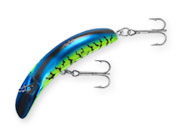December 2010
Freshwater Lure of the Month:
DARDEVLE
The creator of the Dardevle, Lou Eppinger, was making his living as a taxidermist in SE Michigan at the end of the 1800’s. When Eppinger’s business hit somewhat of a slump, he decided to sell lures alongside his taxidermy services in order to help make ends meet. As the tackle end of his business grew, Eppinger soon began to experiment with lures of his own design. While on a fishing trip in the Canadian woods, Eppinger took along a spoon he had handcrafted back in Michigan. He was pleasantly surprised with the results. Eppinger particularly liked the long distances he could cast his lure—even into a stiff wind. On top of everything, Eppinger’s prototype actually caught more fish than any other bait he fished on the trip.
After quite a bit of tinkering, Eppinger’s first lure made its official American debut in 1912. Initially Eppinger called his lure the Osprey. Eight years later, Eppinger changed the name of his wonder-lure to the Dardevle after the Marines, who had been nicknamed the “Dare Devils” for their feats of bravery in the first World War. Today, Eppinger’s trademark red-and-white stripped Dardevle is perhaps the most recognizable and omnipresent lures ever to hit the fishing scene. Alongside his trademark paint scheme, anglers will find dozens of color and size combinations. Although all the colors have their fans, FE is partial to the classic red-and-white.
Featured lure: Dardevle
Created by: Lou Eppinger
Created: c. 1912
Manufacturer: Eppinger Manufacturing Company
Type: Spoon
Technique:
While this lure is not considered to be the most versatile of all lures, as many anglers will confirm, it’s highly effective when others simply are not. The Dardevle can be relied upon to be a good selection for a broad number of species when fished with a consistent, moderate to rapid retrieve. If you haven’t used the Dardevle while trolling, you could be in for a surprise.
www.FishingEnthusiast.com
www.FishingEnthusiast.com












